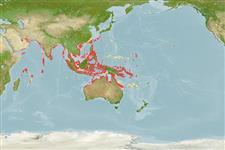Elasmobranchii (hajar och rockor) (sharks and rays) >
Myliobatiformes (Stingrays) >
Myliobatidae (Eagle and manta rays)
Etymology: Aetomylaeus: Greek, aetos = eagle + Greek, mylio = mill, grinder (Ref. 45335).
More on author: Gray.
Environment: milieu / climate zone / depth range / distribution range
Ekologi
marina; brackvatten revassocierade; djupintervall 1 - 18 m (Ref. 37816). Tropical; 30°N - 23°S, 51°E - 167°E
Indo-West Pacific: India to China and Indonesia.
Length at first maturity / Size / Vikt / Age
Maturity: Lm 63.0, range 54 - 72 cm
Max length : 200 cm WD hane/ej könsbestämd; (Ref. 30573)
With distinctive color pattern and exceptionally long spineless tail over six times the length of the body (Ref. 37816).
Found inshore (Ref. 9862). Inhabits mangrove creeks and protected sandy channels to a depth of at least 18 m; relatively uncommon (Ref. 37816). Active swimmer, travelling long distances; feeds on crustaceans and molluscs (Ref. 68964). Ovoviviparous (Ref. 50449). Caught occasionally by bottom trawl, tangle net and inshore gillnet fisheries. Utilized for its meat, but of limited value as it is not frequently landed (Ref. 58048). Presumably utilized for human consumption in the western central Pacific (Ref. 9862).
Life cycle and mating behavior
Könsmognad | Reproduktion | Lek | Ägg | Fecundity | Larver
Exhibit ovoviparity (aplacental viviparity), with embryos feeding initially on yolk, then receiving additional nourishment from the mother by indirect absorption of uterine fluid enriched with mucus, fat or protein through specialised structures (Ref. 50449).
Mould, B., 1994. A world list of rays. The scientific nomenclature and distribution of the recent Batoidea (Batoidea, Elasmobranchii, Chondrichthyes). University of Nottingham, [UK]. 82 p. (Ref. 8630)
IUCN Red List Status (Ref. 130435)
Threat to humans
Traumatogenic
Human uses
Fiskeri: mindre kommeriell
Ytterligare information
referenserVattenbrukVattenbruksprofilAvelslinjerGenetikElectrophoresesÄrftlighetSjukdomarBehandlingNutrientsMass conversion
Verktyg
Special reports
Download XML
Internet-källor
Estimates based on models
Preferred temperature (Ref.
123201): 25.6 - 29.3, mean 28.6 °C (based on 2218 cells).
Phylogenetic diversity index (Ref.
82804): PD
50 = 0.5078 [Uniqueness, from 0.5 = low to 2.0 = high].
Bayesian length-weight: a=0.00389 (0.00123 - 0.01235), b=3.08 (2.82 - 3.34), in cm total length, based on LWR estimates for this (Sub)family-body shape (Ref.
93245).
Trofisk nivå (Ref.
69278): 3.8 ±0.5 se; based on size and trophs of closest relatives
Resiliens (Ref.
120179): Låg, lägsta populationsfördubblingstid 4,5-14 år (Fec assumed to be <100).
Fishing Vulnerability (Ref.
59153): Very high vulnerability (83 of 100).
